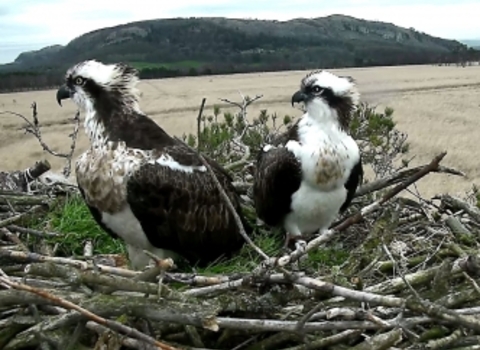Perch on a cliff edge or town hall top beside an osprey, peregrine falcon or barn owl with The Wildlife Trusts’ webcams! The popularity of the charities’ wildlife webcams has continued since they soared by more than 2,000 per cent during the pandemic, and they are still one of the best ways to get up close and enjoy nature’s most spectacular sights.
Watch live footage, some with sound such as the eerie squawk of an osprey and the mewing of a barn owl chick. Webcams also include occasional views of red squirrels, dolphins and badgers. But it is the live images of wild birds caring for chicks or returning with prey that provide the most reliable footage – endearing to some, alarming to others – and the webcams continue to be one of the most popular pages on The Wildlife Trusts’ website.
Top webcams include:
- After 25 years of the hugely successful Rutland Osprey Project and more than 200 chicks, people at home can watch a nesting pair close up, while they fish, nest and incubate three precious eggs.
- Cute barn owl fledglings at Dorset Wildlife Trust’s Lorton Meadows.
- The first peregrine falcon chick hatched on top of the Nottingham Trent University Newton building at 7am on May 3rd. Two further chicks may not be far behind.
Teams at Wildlife Trusts across the country have been scaling great heights and, in some cases, braving big seas to place webcams in unobtrusive places so as not to disturb the wildlife for unrivalled live footage. For example, Alderney Wildlife Trust’ puffin camera is situated two miles offshore and very exposed to the elements. While there are occasional interruptions to streaming, the teams try to ensure that services are running 24/7.
Rob Stoneman, director of landscape recovery at the Wildlife Trusts, says:
“There’s nothing better when you are stuck in the office or at home than clicking on the webcam link and feeling like you are sitting in the sun on a coastal cliff looking out over the sea on the west coast of Wales quietly watching the puffins and gannets as the flock to western shores from their winter nesting grounds. Watching them take off and swoop down and prepare for their next flight is wonderful.
“Webcams allow an unrivalled view of intriguing behaviours from courtship, nesting, and hatching to a peep into the first few weeks of a chick's life and the ever-important preening of feathers before their next flight. The wildlife webcams can cost around £12,000 to purchase and keep these cameras running for the season, so if you enjoy watching these cameras please donate.”

